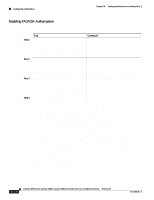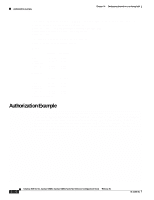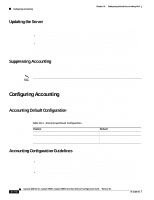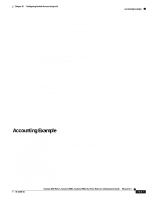Cisco WS-C2980G-A Software Guide - Page 492
Accounting Overview, Accounting Events, Specifying When to Create Accounting Records
 |
UPC - 746320423555
View all Cisco WS-C2980G-A manuals
Add to My Manuals
Save this manual to your list of manuals |
Page 492 highlights
Understanding How Accounting Works Chapter 30 Configuring Switch Access Using AAA Accounting Overview You can configure these accounting methods to monitor access to the switch: • TACACS+ accounting • RADIUS accounting Accounting allows you to track user activity to a specified host, suspicious connection attempts in the network, and unauthorized changes to the NAS configuration. The accounting information is sent to the accounting server where it is saved as a record. Accounting information typically consists of the user's action and the duration for which the action lasted. You can use the accounting feature for security, billing, and resource allocation purposes. The accounting protocol operates in a client-server model, using TCP for transport. The NAS acts as the client, and the accounting server acts as the daemon. The NAS sends accounting information to the server. After successfully processing the information, the server sends a response to the NAS, acknowledging the request. All transactions between the NAS and server are authenticated using a key. After accounting has been enabled and an accountable event occurs on the system, the accounting information is gathered dynamically in memory. When the event ends, an accounting record is created and sent to the NAS; the system then deletes the record from memory. The amount of memory that is used by the NAS for accounting varies depending on the number of concurrent accountable events. Accounting Events You can configure accounting for the following types of events: • EXEC mode accounting-Provides information about user EXEC sessions (normal login sessions) on the NAS. This information includes the duration of the EXEC session but does not include traffic statistics. • Connect accounting-Provides information about all outbound connections from the NAS (such as Telnet, rlogin). Note If you get a connection immediately upon login and then your connection is terminated, the EXEC and connect events will overlap and will have almost identical start and stop times. • System accounting-Provides information on system events not related to users. This information includes system reset, system boot, and user configuration of accounting. • Command accounting-Sends a record for each command that is issued by the user. This permits audit trail information to be gathered. Specifying When to Create Accounting Records You can configure the switch to gather accounting information and create records. When you configure accounting (using the set accounting command), the switch can generate two types of records: • Start records-Include partial information of the event (when the event started, type of service, and traffic statistics). • Stop records-Include complete information of the event (when the event started, its duration, type of service, and traffic statistics). 30-48 Catalyst 4500 Series, Catalyst 2948G, Catalyst 2980G Switches Software Configuration Guide-Release 8.1 78-15486-01















